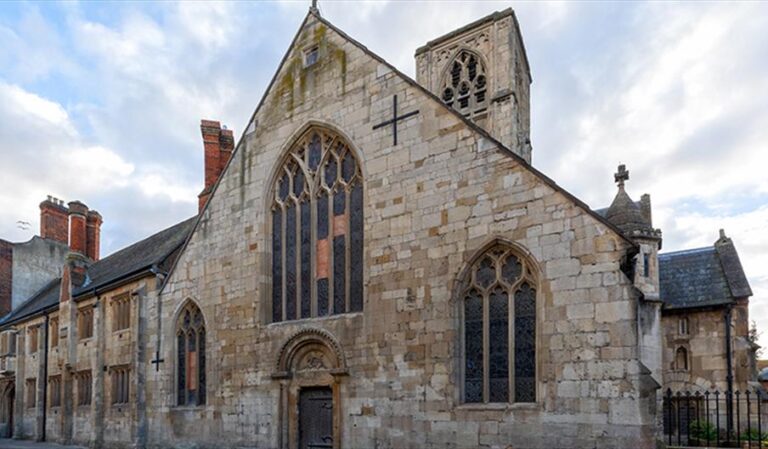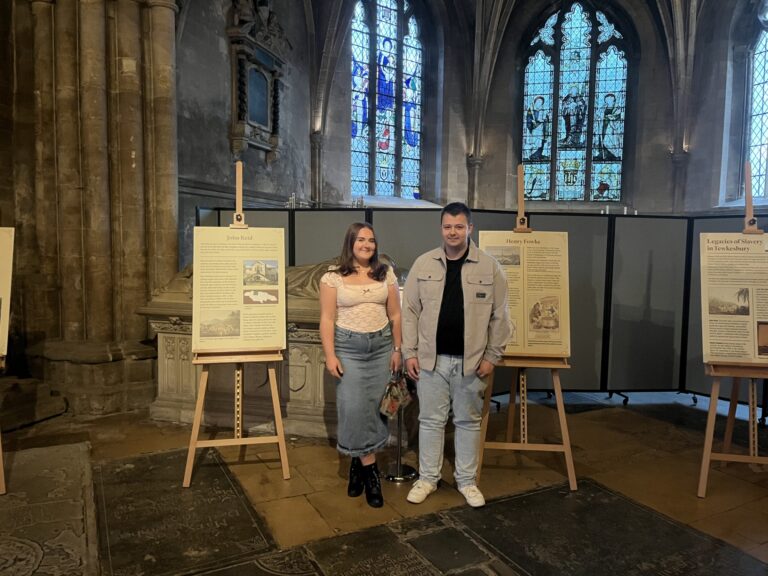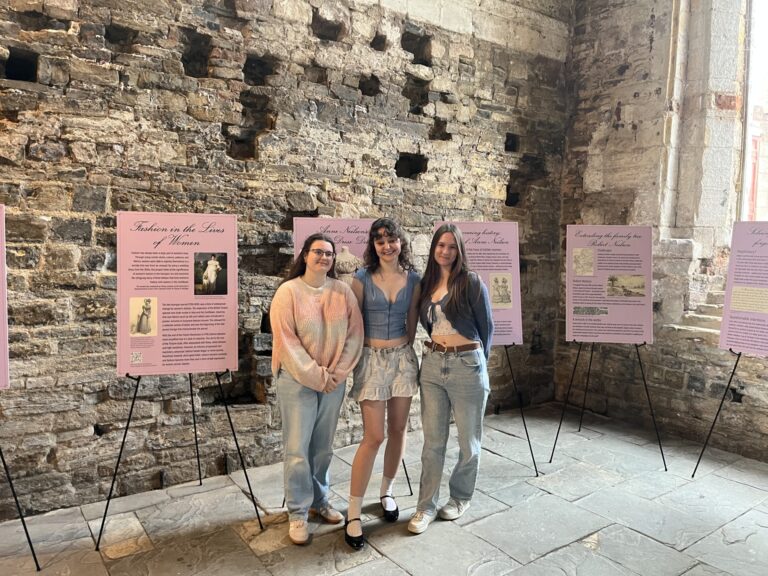| CC4HH
Slavery and Abolitionism in Gloucestershire
The following projects were created by two groups of BA History students, and were exhibited at the City Voices festival in Gloucester, September 2022.
The project on William Prescod was conducted by Sam Burgess, Steve Hannis, Harvey Pearce, Tom Gullick and Ben Haidon.
Jump to: Timeline | William Hinds Prescod | Prescod in Cheltenham | Prescod’s Investments | Prescod in Barbados | Prescod’s wider legacy
The project on Samuel Bowly was conducted by Jordan Rosewarne, Callum Hughes and Lydia Horwell.
Introduction | The life of Samuel Bowly | Samuel Bowly the abolitionist | Temperance League
Timeline of the Abolition of Slavery in the British Empire
1772 – The case of James Summerset: rules that a slave cannot be transported from England against their own will.
1780s – William Wilberforce founds the anti-slavery society known as the ‘Clapham Sect.
1787 – Wilberforce unsuccessfully brings the issue of slavery before parliament.
1807 – Parliament passes the Slave Trade Act preventing the purchase of slaves from Africa; but the punishment was only a fine.
1811 – the Slave Trade Felony Act makes trading illegal. The Royal Navy enforced this act around the coast of West Africa.
1816 – Bussa’s Rebellion, the largest slave rebellion in Barbadian history, one of many revolts in the West Indies.
1833 – The Abolition of Slavery Act, which took effect from 1 August 1834. It outlawed slavery in legal terms but slaves remained ‘apprentices’. Around £20 million paid out to compensate slave-owners for their ‘losses’.
1838 – Full legal emancipation for all slaves becomes law.

William Hinds Prescod
The first part of this project picks up on recent debates about Britain’s colonial past and the hidden legacies of the slave trade at a local level.
The UCL Legacies of British Slavery database lists 92 slave-owners living in Cheltenham who received compensation after slavery was abolished in 1833. These publicly available documents show the claims made by slave-owners for compensation, the funds they received as well as the properties and numbers of enslaved people they possessed. William Hinds Prescod moved to Cheltenham after abolition. He received £37,000 (equivalent to £4,000,000 today) in compensation claims. He was born around 1775 in Barbados to white parents. He studied Law at Cambridge. In 1815, he inherited plantations from his uncle, making him the largest slave-owner in Barbados.
Only fractions of Prescod’s life and legacy are evident today, but what remains allows us an insight into the complicated and contradictory nature of this history.
William Prescod in Cheltenham
Alstone Lawn
Prescod’s considerable wealth, much of which came from compensation allowed him to purchase the large estate of Alstone Lawn. He lived here until his death in 1848, after which it became the property of his wife, Mary (d. 1860), and their adopted daughter, Mary Prescod Gurney (d. 1911).
Alstone Lawn was considered to be one of the grandest estates in Cheltenham. Its grandeur and association with capitalist greed, however, made it a target for the suffragettes, who burned it down in 1913.

Getting around town
Prescod had a flash yellow carriage noted by many Cheltenham residents. It was driven by one of Prescod’s many employees, Mr Wm Tye, who served Prescod for 45 years. Prescod displayed his wealth and was not afraid to be the centre of attention.
The carriage pictured is similar to the one Prescod was described as having.
Assembly Rooms
Prescod and his wife were known to frequent the Assembly Rooms (now the Everyman Theatre). This was a place for the wealthy Cheltonian to buy and trade art, attend lavish dinners, and watch the latest ballet.


Prescod and his wife were amongst the largest shareholders in the establishment with 5 shares between them (see picture). These shares were purchased in 1835 at a cost of £500 (equivalent to £33,900 today). It was also a site where local abolitionists met and debated their cause.
Prescod’s Grand investments
After moving to Cheltenham, Prescod embarked on a series of ‘Grand Tours’ mirroring the journeys of many wealthy Victorians of his age. He toured the European continent, visiting many places of cultural interest, mainly in Italy.
During these trips, Prescod purchased paintings and built a vast art collection that included works by prominent artists, such as van Dyke, Titian and Rembrandt. The calibre of these works is a reflection of Prescod’s wealth.
Following Prescod’s death, his art collection was sold at auction in a process that took 3 entire days.
In the years following the abolition of slavery, many former slaveholders looked for ways to invest their compensation. As well as investing in buildings, business and infrastructure, many invested in art.

In 2018 and before the Black Lives Matter protests of 2020, the National Gallery conducted a study into the artwork in their collections in an attempt to identify links to the slave trade. Published in November 2021, the report found at least 67 donors and trustees with links to slavery.
The most prominent painting they linked to compensation money was Leonardo da Vinci’s Virgin of the Rocks.
Prescod in Barbados
Colonialism and slavery in Barbados
The first English ship carrying 90 colonists landed on Barbados in 1625. The labour forces working the sugar – the island’s primary crop – were originally made up of indentured white labourers. As was the case in many colonies, indentured labourers were gradually replaced by African slaves. Slavery was deemed to be much more profitable. As a result, Barbados became a focal point in the triangle of the Atlantic slave trade. By 1650 Barbados had 44,00 colonists. In the 1650s, there were 3 slaves to every plantation owner.


In the book The First Black Slave Society: Britain’s ‘Barbarity Time’ in Barbados, 1636-1876, historian Hilary Beckles argues that Barbados was the birthplace of British slave society and that the island was the ruthlessly colonized by Britain’s ruling elites.
Prescod’s Holdings and the Paradoxes of Slave-ownership
Prescod spent 30 years as a slave holder in Barbados. The major beneficiary from his uncle’s estate, he inherited land and slaves. In 1822, he was listed as holding 352 slaves and 794 acres of land split across just 12 sites.
During this time he undertook initiatives that complicate our interpretations of his activities. In Barbados, Prescod fathered 4 illegitimate children with a freed slave named Lydia Smith. One of these mixed-race children grew up to be a prominent Barbadian politician: Samuel Jackman Prescod. He also freed 21 slaves during his time in Barbados, although the motivation for these ‘manumissions’ is unclear. Does this indicate conflicted views about his slave-holding?
Prescod was not the only beneficiary of his uncle’s will, an issue that was heavily contested. In his compensation claim, Prescod remarked that his relatives intended to put their hands into my pocket.
Prescod’s wider legacy in Barbados
Samuel Jackman Prescod: an abolitionist and ‘radical’
Samuel was born in 1806, to William Prescod and a freed slave. He was educated by his mother and began advocating for equal rights in his 20s.
In 1829, after a speech in the Barbadian parliament, Samuel was hit with umbrella and kicked out. After this incident, he travelled to England to study law, seemingly following in his father’s footsteps. Although Samuel never graduated, he witnessed the abolition movement in its prime.
This was a vital experience for Samuel. He returned to Barbados and began a career as a journalist. He initially wrote for The Times but lost his position due to his ‘radical’ ideas. He moved to The Liberal, a paper he later co- owned. In 1840, Samuel attended the famous anti-slavery convention in London, demonstrating the opposing view he probably held to his father.
He became the first person of African descent to be elected to the Parliament of Barbados in 1843, and formed The Liberal Party. Samuel’s legacy lives on in Barbados. His likeness appears on Barbadian bank notes and stamps.

Links to Education and a Barbadian Reverend
After William Prescod’s death in 1848, The Barbadian reported that he had left no will for his land. The land was given to a Reverend William Prescod Hinds, which suggests the two men were probably related.
Reverend Hinds founded the Saint Peter’s Benevolent National School in Barbados in 1826. The school’s second annual report, published in 1827 in The Barbadian, notes the school as educating 21 freed children and 18 enslaved children. Accounts of the school indicate that the children were being taught how to read and write, as well as maths. It was extremely rare for enslaved people to receive any kind of education.
Reverend Hinds was elected Chaplain to the Colonial Parliament in Barbados in 1833. He moved from Barbados to Philadelphia, only to return in 1849 after inheriting land from William Prescod. On his return to Barbados, Reverend Hinds again became involved with local politics.


Conclusions
The examples from Prescod and his family demonstrate the complicated legacies of this history. They include huge profiteering from slavery, relationships with former slaves, mixed-race children, and abolitionism within the same family.
Samuel Bowly: A Prominent Abolitionist
The second part of this exhibition focuses on the life and work of a Gloucestershire-based abolitionist, Samuel Bowly (sometimes written Bowley).
Samuel Bowly was born on 23 March 1802 in Bibury, Cirencester. He is mostly recognised for his active role as an abolitionist in the 19th century. During his youth, Bowly received a good education in how to run a business from his father, Samuel Bowly Snr. Following in his father’s footsteps, Bowly joined the Society of Friends (the Quakers), a denomination of protestant Christians with the shared belief in every human’s ability to experience the light within or see ‘that of God in every one’. They were the first religious group openly to oppose against slavery. Bowly also dedicated much of his life to being a leader in commercial affairs. As a strong supporter of a national system of education, he called for education to be accessible to everyone. He was a much loved and respected man of his generation.

The Abolitionist Movement
The abolitionist movement directed its efforts to bringing about the end of slavery and to liberating enslaved peoples. It emerged in the late 18th century, and became of the most important and influential reformist movements of both the 18th and 19th centuries. Quakers played a significant role in this movement. In Britain, pressure and campaigning by the movement led to the transatlantic slave trade being declared illegal in 1807. It took a further 26 years for the practice of slavery throughout the British colonies to come to an end in 1833.

Why Bowly?
Bowly had many accomplishments as a leader in both the abolitionist and the temperance movements. As a leader in the abolitionist movement, Bowly petitioned for the better treatment for former slaves, and he led many marches on Downing Street. He was one of the prominent abolitionists who attended the first convention of the World Anti-Slavery Society in London in 1840. As a leader in the temperance movement, Bowly was one of best known and influential Quakers in the country.
The life of Samuel Bowly
23 March 1802 – born in Bibury
1829 – moved to Gloucester
1835 – signed pledge of total abstinence from alcohol; formed a teetotal society
14 November 1837 – led a deputation to Downing Street to interview Lord Melbourne
1838 – took part in the formation of The Central Negro Emancipation Committee
12 June 1840 – attended the World Anti-Slavery Convention in London
1850 – became a leading member of the Society of Friends, otherwise known as Quakers
12 June 1840 – attended the World Anti-Slavery Convention in London
1853 – during the early stages of the Crimean War, became involved in the Peace Movement
1863 – became a Minister of the Society of Friends
23 March 1884 – died on his 82nd birthday
19 October 2017 – Plaque unveiled at his former home on 65 Park Rd, Gloucester
IMAGE
Samuel Bowly the abolitionist
Working against the apprenticeship system
After the formal abolition of slavery, Bowly led a delegation to meet with the Prime Minster, Lord Melbourne (pictured), to discuss the cruelties that slaves were enduring through the apprenticeship system. Following the abolition of slavery in 1834, this system meant that freed slaves had to work on the plantations of their former masters as apprentices for up to 6 years for their former owners. Some former slaves argued that life became more difficult under this system as the authorities clamped down harder on workers with punishments.

The Central Negro Emancipation Committee
In 1838, Bowly formed the Central Negro Emancipation Committee, and he again petitioned Downing Street to bring a bill to parliament for the abolition of the apprenticeship system. The first attempt failed, but the second succeeded. As a result of pressure from abolitionists and formerly enslaved people, the apprenticeship system ended two years earlier than planned in 1838.
The Committee was a more radical offshoot of the Anti-Slavery Society, which had a long history of campaigning for the abolition of slavery and the improvement of conditions for slaves and indigenous populations.

World Anti-Slavery COnvention
In 1840, Bowly attended the World Anti-Slavery Convention in London. This convention was attended by a number of prominent abolitionists, including William Lloyd Garrison, Joseph Pease and William Adam, as well as Samuel Jackman Prescod.
Another major issue discussed at the convention was that of women’s rights. Although women were excluded from taking part directly in the proceedings, the convention brought together two of the most important women in the early women’s rights movement in America: Elizabeth Cady Stanton and Lucretia Mott.

Samuel Bowly and the Temperance League
National Temperance League
Bowly was a reformer in more ways than one. On 30 December 1835 Bowly signed a pledge of total abstinence from alcohol, and on the same day he formed a teetotal society in Gloucestershire, based in Cirencester. He was incredibly devoted to his mission of abstinence, and led several different organisations: President of the National Temperance League and Director of United Kingdom Temperance and General Provident Institution. He attended and addressed over 100 meetings in the last year of his life on behalf of the National Temperance League and was notable for drawing the attention of scientists to the harmful effects of alcohol.
Coaching inns and taverns were important staging posts for travellers, and they also served as places to drink for locals. Gloucestershire had a number of important inns of note, and drinking was a common recreation for working men.
Changes to the licensing laws in the 1828 Alehouse Act and the 1830 Beerhouse Act introduced greater regulation of inns, taverns and pubs. The acts were partly introduced with the hope of reducing the consumption of spirits and restricting the sale of alcohol to licensed premises. The acts increased competition between brewers and suppliers, thereby bringing down the prices of ale and beer and making alcohol cheaper and more readily available. The 1830 act was criticised for promoting drunkenness.

Repurcussions
Despite efforts to reduce levels of drunkenness, these measures gave businesses an incentive to create more pubs, especially when beer was so cheap to produce and people could drink more of it. The nineteenth century licensing laws were not repealed until 1993. Despite Bowly’s efforts, the temperance movement struggled and faded before the turn of the twentieth century. The pub was simply too popular a place to convince most people to go teetotal.




